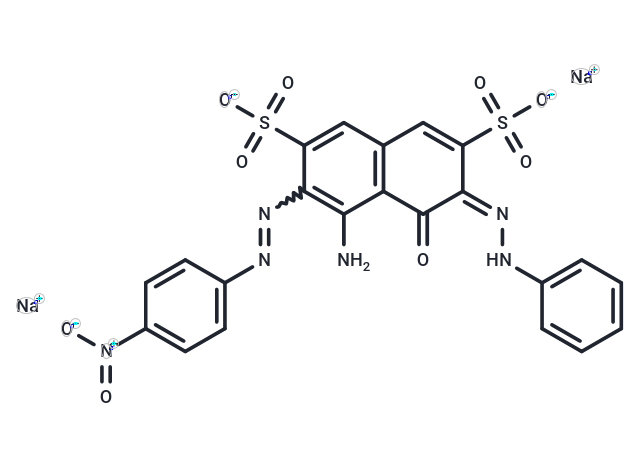Shopping Cart
Remove All Your shopping cart is currently empty
Your shopping cart is currently empty
Amido Black 10B (Naphthol Blue Black) is a highly toxic azo dye used for staining proteins on polyacrylamide gels and agarose gels.

| Pack Size | Price | USA Warehouse | Global Warehouse | Quantity |
|---|---|---|---|---|
| 1 g | $29 | 7-10 days | 7-10 days |
| Description | Amido Black 10B (Naphthol Blue Black) is a highly toxic azo dye used for staining proteins on polyacrylamide gels and agarose gels. |
| Cell Research | Instructions I. Preparation of reagents: Configuration of mother solution and working solution: Amido Black 10B is usually provided in the form of solid dye. It needs to be dissolved in water or 50% methanol solution before the experiment. The commonly used concentration range is 0.1% to 0.5% (w/v), and the specific concentration can be adjusted according to the experimental requirements. Note: When the dye is dissolved, a mixture of methanol and acetic acid (usually a 1:1 ratio) can also be used to improve the protein binding effect. II. Protein staining on polyacrylamide gel: Gel preparation: After completing the electrophoresis, remove the gel and rinse it briefly with distilled water to remove excess buffer. 1. Staining process: Immerse the gel in the prepared Amido Black solution. The staining time is usually 30 minutes to 1 hour, which can be shortened (15 minutes) according to the experimental needs. 2. After the dye binds to the protein, a dark blue or black complex will be produced. 3. Washing: 1) After staining, wash the gel thoroughly with a destaining solution (usually 7% acetic acid and 5% methanol, or 7% acetic acid alone) to remove unbound dye. 2) The washing time is usually 30 minutes to 1 hour, during which the destaining solution needs to be changed. 3) The protein bands should be clearly visible and contrast with the transparent gel background. 4 Visualization: 1) After washing, the staining results can be observed and recorded by conventional lighting or using a gel imaging system. 2) Using a scanner or gel documentation system, the staining intensity can be quantified at a wavelength of approximately 600–650 nm to analyze the staining intensity. 3. Protein staining on agarose gel: The operation of agarose gel electrophoresis is the same as that of polyacrylamide gel, using the same staining and destaining methods. 4. Data analysis: 1. The concentration of the protein can be estimated by the staining intensity of the protein band. The size of a specific protein can be determined by comparison with a molecular weight standard. 2. Use a densitometer or imaging software to further quantify the intensity of the bands for comparative analysis between the experimental group and the control group. Notes: 1. Toxicity: Amido Black 10B is a toxic dye. Appropriate safety measures should be taken during operation, such as wearing gloves, lab coats, and goggles, and ensuring that the operation is carried out in a well-ventilated environment. 2. Proper disposal: Properly dispose of Amido Black solution and gel according to laboratory safety procedures. 3. Staining time: Staining time may vary depending on the content and size of the protein. Care should be taken to control the staining time and avoid overstaining. 4. Background staining: If destaining is not thorough, background staining may occur, affecting the visibility of the bands. Be sure to destain thoroughly. |
| Synonyms | Naphthol Blue Black, Amido Black Staining Solution 2X |
| Molecular Weight | 616.49 |
| Formula | C22H14N6Na2O9S2 |
| Cas No. | 1064-48-8 |
| Smiles | O=[N+]([O-])C1=CC=C(C=C1)N=NC2=C(S(=O)([O-])=O)C=C3C=C(S(=O)([O-])=O)C(N=NC4=CC=CC=C4)=C(O)C3=C2N.[Na+].[Na+] |
| Storage | keep away from direct sunlight,keep away from moisture | Powder: -20°C for 3 years | In solvent: -80°C for 1 year | Shipping with blue ice/Shipping at ambient temperature. | ||||||||||||||||||||||||||||||
| Solubility Information | DMSO: 30.83 mg/mL (50.01 mM), Sonication is recommended. | ||||||||||||||||||||||||||||||
Solution Preparation Table | |||||||||||||||||||||||||||||||
DMSO
| |||||||||||||||||||||||||||||||
| Size | Quantity | Unit Price | Amount | Operation |
|---|

Copyright © 2015-2026 TargetMol Chemicals Inc. All Rights Reserved.